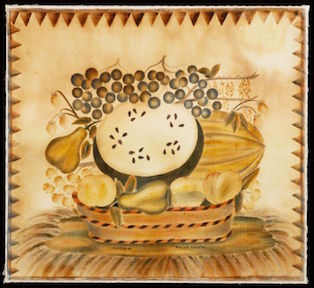 Colonial Williamsburg presents theorem art at Abby Aldrich Rockefeller Folk Art Museum
Colonial Williamsburg presents theorem art at Abby Aldrich Rockefeller Folk Art Museum
By HOLLY PRESTIDGE Richmond Times-Dispatch | Posted: Saturday, December 5, 2015 10:30 pm
“Theorem work,” a popular method of watercolor stencil painting on fabric, wood and paper, was used to decorate everyday objects and create decorative pictures in the 19th century.
An exhibit highlighting the artwork, which was popular as a skill for women, is on display in Colonial Williamsburg.
“Folk art enthusiasts have long associated the art of stencil with 19th-century collections, and we’re excited to share this important and vibrant form of American art with the public,” Laura Pass Barry, Colonial Williamsburg’s Juli Grainger curator of paintings, drawings and sculpture and manager for curatorial outreach, said in a release. “This exhibit will not only depict a variety of theorem compositions and subjects, but it will also show the period process which artists, schoolgirls, and everyday men and women followed to create these colorful creations making them today one of the country’s most recognized and celebrated folk art traditions.”
“Color and Shape: The Art of the American Theorem” at the Abby Aldrich Rockefeller Folk Art Museum features 11 theorems and three stencil designs. Four of the pieces are from the vast 400-item collection that belonged to Abby Aldrich Rockefeller, for which the museum was created.
Many of the pieces from that collection, including original theorems, are on display in Colonial Williamsburg’s Bassett Hall, home to the Rockefeller family during the 1930s and ’40s.
Among the most popular stencil designs to survive the passage of time include those called “The Full Basket” and “Fruit, Bird and Butterfly.”
Paintings on display for the exhibition include designs such as “The Full Basket,” a theorem from 1828 painted by a Massachusetts woman; another, called “Still Life with Watermelon,” is one of only a few that researchers have found were painted by a man. Yet another — “Basket of Fruit” — features a composition of skillfully shaded leaves and fruit painted on cotton velvet.
“The use of stencils provides for bold colors, patterns and shapes that offer an exciting link between the theorem paintings completed by young ladies and the avant-garde pieces created by modern artists almost a century later,” said Kate Teiken, assistant curator of prints, maps and paintings.
